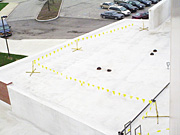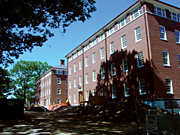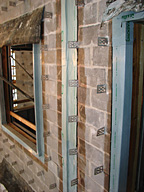Architects Tell Contractors Where to Stick it

Within the roofing industry, spray polyurethane foam (SPF) has long been considered a retrofit solution. But increased interest from architects and specifiers has led to a growth in opportunities for SPF in new construction. According to most roof industry studies, SPF's market share is still quite low compared to that of single-ply or built-up roofing, but its retrofit vs. new construction ratio is in the area of 60/40, consistent with the retro/new split across the entire commercial roofing industry. So is it really unusual to see SPF specified for new construction?
"The word ‘unusual' does not work," says Jack Moore, a civil engineer in charge of technical sales for West Roofing Systems of Ohio. "SPF is possibly ‘less common' in new construction vs. some of the other systems. One of the main reasons SPF excels in the reroofing market is the ability to prepare the existing substrate and install the SPF directly with no tear-off required, giving SPF an economic advantage. SPF is competitive in new construction costs, although there are significantly fewer applicators of SPF vs. single-ply and built-up roofs. We often see a ballasted single-ply specified in new construction due to its very low cost. Owners tend to opt for the 10-year lower cost roof warranty and use the difference available in aesthetic amenities. The lifecycle costs are typically overlooked."
Moses Clark, national accounts manager for BASF Spray Foam Group, reports that most of his sales are made to retrofit applications, but more customers are starting to see the benefits of using SPF for new roofs.
"We have some customers with a very long history of performance like FMC Corporation, Texas A&M University, Kuntztown University and the Dallas Independent School District, as well as numerous other school districts, that will consider using our SPF system on any project, new or retrofit," he says.
In his 30 years of experience, Clark says he's found the biggest hurdle to selling SPF for new construction is the fact that it's a premium system with a moderate price.
"To make the sale and get on the spec, you have to promote the lifecycle value of the system," he says. "The designer is usually only interested in the upfront cost. Most construction projects go over budget and the first thing that is sacrificed in quality is the roof system. Therefore, we have to sell value and long-term maintenance and energy savings."
The other factors that can keep SPF from being included in the new construction spec are seasonal weather conditions and coordination with other trades on the job site.
"I've found that if we can convince the owner and the designer to develop their specification in the fall and begin construction in the spring, we have no weather issues," he says. "To phase the project with other trades, we recommend the installation of a temporary roof or vapor barrier, which will be left in place for the trades to use as a waterproof work surface. This eliminates the issue of physical damages by the HVAC contractors and masonry contractors. The SPF contractor can then install the finished BASF roof system."

"We have been working with the architectural firm for over 15 years. Westlake, Reed, Leskosky Architects has employed George Regula for more than 30 years. He attended a seminar about 15 years ago and grasped the versatility of the SPF roof system, and then utilized the system every opportunity in which he thought it would perform the best," says Moore. "Mr. Regula and I would sit down and review the different applications and details on most of the projects during the design phase."
Moore says the design for the Performing Arts Center created an uncommon building footprint because many of the walls were curved or arced, creating unique sloping patterns to provide the 1/4-in-12 (1.2-degree) slope. Other walls did not provide 90-degree angles and were built on tangent angles, which created difficult flashing details and drainage patterns. In order to turn the architect's imagined design into a built reality, West Roofing installed a 4 1/2-inch-thick BASF Elastospray SPF using auto-slope robotic technology.
"Budget was a big factor on this project. Other systems had to be mechanically fastened with a tapered insulation board. Not only would the design and production of the layout have been extremely difficult, but the labor involved to install the ‘jigsaw puzzle' of tapered insulation would have been extremely intense," says Moore. "From the environmental point-of-view, the roof is EnergyStar®-rated, renewable and a highly efficient insulator. This design firm is heavily involved in LEED™-certified construction means and methods, so that was an important consideration, too."
"This is a high-profile project representing a huge investment for the school district, and therefore a big commitment for the architects. It proves that SPF roofing is a viable system for new construction," he says.
Mason Knowles, executive director of the Spray Polyurethane Foam Alliance (SPFA), attributes success stories like the Westlake Performing Arts Center to more effective awareness-building and marketing efforts.
"We are making great inroads into new construction, mainly as a result of better education of architects, specifiers and construction companies on the value and benefits of SPF systems," he says.
Tom Harris, product manager for BASF Spray Foam Group, says driving the spec through architect education is helping contractors make the sale.
"As a manufacturer, we focus our marketing efforts on educating building owners and facility managers, as well as architects, consultants and specifiers, on the tangible benefits SPF has to offer," he says. "The message we send is that SPF is a high-performance system that will actually cost less because of the benefits it brings to the building. Benefits like low lifecycle cost, sustainability, environmental responsibility, energy efficiency, resistance to severe weather and design freedom. Then we back up our claims with in-field performance data and third-party verified studies."

It Works on the Roof...It Works on the Wall
SPF roofers are also starting to see a "trickle-down" opportunity. As architects learn more about the benefits SPF can bring to the roof, that knowledge is being applied in a way that may well increase SPF's hold in new construction: wall air barrier systems.With the increased interest in designing energy-efficient and sustainable buildings, more and more architects are specifying insulating SPF air barrier systems in the walls of new commercial buildings. Air barriers are, quite simply, a component of the building envelope that controls the movement of air into and out of buildings.
The United States Department of Energy estimates that 40 percent of the energy cost of heating and cooling a building is wasted by uncontrolled air leakage through the building envelope. A recent study from the National Institute of Standards and Technology (NIST) shows that an effective air barrier system can reduce air leakage-by up to 85 percent-for significant energy savings: natural gas savings up to 40 percent and electricity savings up to 25 percent. Massachusetts mandates the use of air barriers in its Commercial Energy Code, and approximately 29 other states include air barriers in their provisional codes.
The Air Barrier Association of America (www.airbarrier.org) approves the use of specific SPF air barrier systems to meet state commercial energy codes. Not surprising, when Canadian architects and builders have successfully used closed-cell SPF insulating air barriers for 15 years.
"The use of SPF as an air barrier material is the second fastest growth market behind residential. In terms of potential, the air barrier opportunity holds a far greater promise. Our numbers show increase rates in the 200-400 percent range," says Harris. "This is significant to BASF as it represents an opportunity to move polyurethane chemicals and sustain the growth rates expected by our shareholders. To the industry it means another opportunity for members to diversify their cash flow base by including new construction activities in addition to retrofit roofing. For the building owner it means we have developed a means to deliver a better building envelope to address their needs today and in the future."
As one of the leading SPF roofing firms in the United States, West Roofing and Jack Moore know an opportunity when they see one. Not only are they capitalizing on SPF roofing for new construction, the company sent team members for ABAA certification so it could take advantage of the growth potential represented by the burgeoning air barrier market.
"We're currently about halfway through a big wall project for the Detroit Institute of Art in downtown Detroit," says Moore. "It's 75,000 square feet with a 3-inch specified thickness."
Moore and West Roofing aren't alone. Knowles reports that the SPFA accreditation course 101 BE (building envelope) was very well attended at the organization's annual conference, Spray Foam 2005, where "Enrollment was triple the previous year."
Why the sudden popularity? Because contractors know that where there's a spec, there's a bid they can win, and architects are specifying for the benefits of SPF air barrier systems. Shaun Landon, project manager for Shepley Bulfinch, Richardson and Abbott, a Boston architectural firm, says SPF creates "a tight, efficient, high-performance building envelope."
Landon was part of the recent modernization of James and Stearns residence halls at Amherst College in Amherst, Mass. The architect's original plan for the Massachusetts-mandated air barrier system was a liquid-applied vapor barrier with rigid insulation on top. But Shepley Bulfinch is one of an increasing number of New England firms that have gone beyond the simple air barrier mandate and is focused on air-barrier systems that are sympathetic to the highest expectations of field quality control.
"We are recommending spray foam on many projects. We brought in the construction manager early in the process to view a spray foam application on another building. He accepted it with open arms. We then recommended spray foam to Amherst College, whose people had not seen the concept before. They quickly realized that this was not only a quality air barrier and insulation product, but that the schedule would benefit as well," says Landon.
In addition to using medium-density, two-component SPF specially formulated for air barrier performance in the walls, the Amherst project also employed the use of one-component insulating foam sealant to ensure air barrier continuity-another product best-known for its retrofit benefits that is beginning to see increased use in new construction.
Will SPF roof and air barrier combine on the same building one day? BASF has coined the phrase "Engineered Building Envelope System" or EBE to describe it-engineered because the chemicals in the different systems are engineered on the molecular level for their specific application, be it roof, wall or sealant.
"I feel the EBE will happen soon. It's actually already happening in the
Southwest in the residential market. We see many customer homes in the mid and eastern north that use SPF in the walls and under roof sheathing in
residential applications. For the industrial commercial sector-I would suggest we are five to 10 years away," says Harris.

Is SPF Just Following the Trend?
Is the increased visibility of SPF systems in new construction an indication of a larger trend? Certainly economists are predicting growth in new construction, and according to McGraw Hill Construction, the first five months of 2005 saw a 2-percent increase in construction across the United States over the same period in 2004.Other trends that seem to be carrying SPF along for the ride are the state commercial energy codes and the increased demand from building owners and managers for high-performance buildings. Or could it be that SPF, so long considered an "alternative" system, is finally shedding its former reputation and joining the mainstream? Time, and the performance of the systems being installed today, will tell.
Looking for a reprint of this article?
From high-res PDFs to custom plaques, order your copy today!




